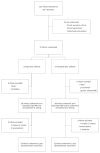A pilot randomized trial of high-dose caffeine therapy in preterm infants
- PMID: 25856169
- PMCID: PMC4928641
- DOI: 10.1038/pr.2015.72
A pilot randomized trial of high-dose caffeine therapy in preterm infants
Abstract
Background: Standard-dose caffeine improves white matter microstructural development assessed by diffusion magnetic resonance imaging (MRI). We hypothesized that early high-dose caffeine would result in further improvement in white matter microstructural development.
Methods: Seventy-four preterm infants (≤30 wk gestational age) were randomly assigned to either a high (80 mg/kg i.v.) or standard (20 mg/kg i.v.) loading dose of caffeine citrate in the first 24 h of life. MRI and neurobehavioral testing were undertaken at term equivalent age. Infants returned at 2 y of age for developmental testing.
Results: Clinical characteristics were similar between groups, with the exception of higher maternal age in the high-dose caffeine group. There was an increased incidence of cerebellar hemorrhage in infants randomized to high-dose caffeine (36 vs. 10%, P = 0.03). Infants in the high-dose caffeine group also demonstrated more hypertonicity (P = 0.02) and more deviant neurologic signs (P = 0.04) at term equivalent age. Diffusion measures at term equivalent age and developmental outcomes at 2 y of age did not differ between groups.
Conclusion: Preterm infants randomized to early high-dose caffeine had a higher incidence of cerebellar injury with subsequent alterations in early motor performance. The results of this pilot trial discourage a larger randomized controlled trial.
Conflict of interest statement
Figures
References
-
- Barrington K, Finer N. The natural history of the appearance of apnea of prematurity. Pediatr Res. 1991;29:372–375. - PubMed
-
- Schmidt B, Roberts RS, Davis P, et al. Caffeine therapy for apnea of prematurity. N Engl J Med. 2006;354:2112–2121. - PubMed
-
- Schmidt B, Roberts RS, Davis P, et al. Long-term effects of caffeine therapy for apnea of prematurity. N Engl J Med. 2007;357:1893–1902. - PubMed
-
- Schmidt B, Anderson PJ, Doyle LW, et al. Survival without disability to age 5 years after neonatal caffeine therapy for apnea of prematurity. JAMA. 2012;307:275–282. - PubMed
Publication types
MeSH terms
Substances
Grants and funding
LinkOut - more resources
Full Text Sources
Other Literature Sources
Medical


